Are you ready to embark on a journey of creating your dream garden for every season? Whether you are a beginner, have limited space, want to attract wildlife, seek relaxation, prioritize health and sustainability, cater to kids or therapeutic needs, this article has you covered with useful tips and tricks.
Creating your dream garden for every season requires some tips and tricks to help you achieve the desired outcome. One important tip is to understand the amount of sunlight your garden will receive, as different plants have different sunlight requirements. Having a garden plan in place before planting is also essential, especially when dealing with vining plants that can overtake other areas of the garden. Additionally, there are several DIY techniques that can enhance your gardening experience.
For instance, adding Epsom salt to the planting hole can improve flower blooming and plant growth, while a garlic-hot chili foliage spray can naturally repel insects. Making your own compost is a cost-effective alternative to buying it, and growing plants from seeds instead of buying them can save you money in the long run.
ther cost-saving ideas include growing your own fruit and vegetables, participating in plant and seed swaps, regularly removing weeds, using mulch to retain moisture and prevent weeds, collecting rainwater, practicing companion planting for natural pest control, avoiding hiring a gardener, building a raised bed, and sharing or borrowing tools with friends and neighbors. With these tips and tricks, you can create and maintain a stunning garden throughout every season.
Key Takeaways:
- Understand the amount of sunlight your garden will receive and plan accordingly.
- Use DIY techniques like adding Epsom salt to improve plant growth and using a garlic-hot chili foliage spray to repel insects.
- Cost-saving ideas include making your own compost, growing plants from seeds, and participating in plant and seed swaps.
- Retain moisture and prevent weeds by using mulch, collecting rainwater, and practicing companion planting for natural pest control.
- Consider building a raised bed and sharing or borrowing tools with friends and neighbors to save money.
Planning Your Garden According to Sunlight Exposure
Before you start planting, it’s crucial to understand how much sunlight your garden area will receive throughout the day, especially if you are a beginner or working with limited space.
Different plants have different sunlight preferences, and a garden plan is essential to ensure that plants are placed in the most suitable locations. For example, sun-loving plants should be placed in areas that receive at least six hours of direct sunlight per day, while shade-loving plants require only two to four hours of indirect sunlight.
If you have limited space, consider planting in containers or raised beds that can be moved throughout the day to ensure adequate sunlight exposure for your plants.
| Plants that Prefer Full Sun | Plants that Prefer Partial Shade | Plants that Prefer Full Shade |
|---|---|---|
| Tomatoes | Lettuce | Hostas |
| Peppers | Spinach | Ferns |
| Zucchini | Broccoli | Begonias |
| Cucumbers | Kale | Astilbe |
When planning your garden, keep in mind that vining plants require enough space to grow without overtaking other plants. Consider using trellises or cages to support vining plants such as tomatoes or beans.
In addition to proper sunlight exposure, there are several tips and tricks to help your garden thrive. For example, adding Epsom salt to your soil can improve plant growth and promote healthier foliage. Making a garlic-hot chili foliage spray can also repel insects and protect your plants naturally.
Growing your own fruit and vegetables from seed or investing in perennial plants can be cost-effective options for creating a beautiful garden without breaking the bank. Regularly removing weeds, using mulch to retain moisture, collecting rainwater, and practicing companion planting can also help save money and promote a healthy garden.
Instead of hiring a gardener, consider doing the gardening yourself and sharing or borrowing tools to cut costs. By planning your garden according to sunlight exposure and implementing these money-saving tips, you can create the garden of your dreams without spending a fortune.
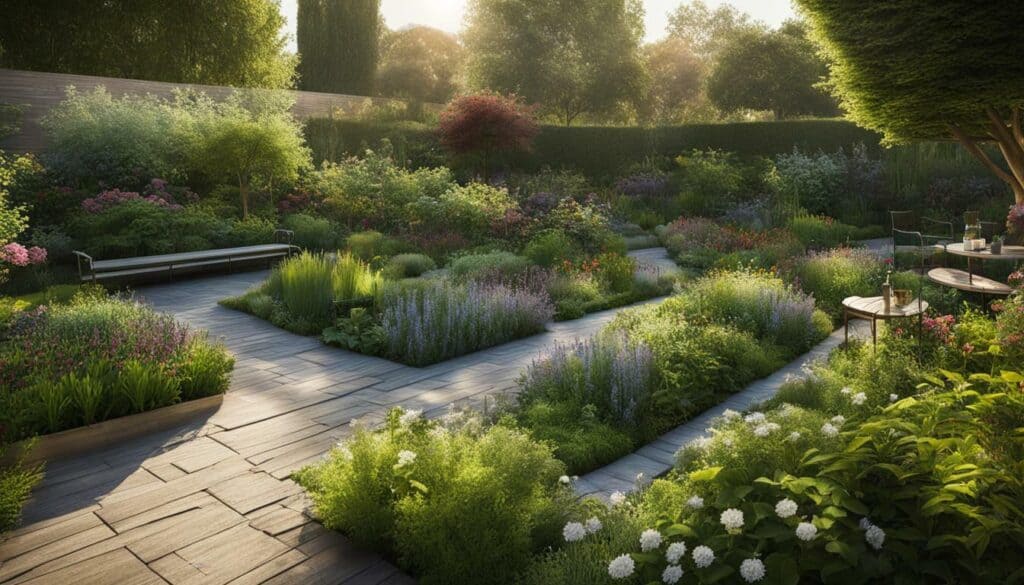
Enhancing Flower Blooming and Plant Growth with Epsom Salt
Did you know that adding Epsom salt to your planting holes can work wonders for flower blooming and overall plant growth, making it a great technique for both beginners and those looking to create a healthier garden?
Epsom salt, which is a naturally occurring mineral, contains magnesium and sulfur – two elements that are essential for plant growth. By adding a tablespoon of Epsom salt to the planting hole or soaking the root balls in a diluted Epsom salt solution, you can enhance the green color of plants and improve flower blooming.
This technique is particularly useful for those who are new to gardening and want to ensure their plants are as healthy as possible. Plus, since Epsom salt is an affordable and readily available product, it’s a great way to save money on expensive fertilizers and plant treatments.

In addition to using Epsom salt, there are other ways to save money and make your garden more sustainable. Making your own compost, for example, is an easy and cost-effective way to provide your plants with the nutrients they need. Growing plants from seed is another great money-saving technique, and collecting rainwater can help keep your plants healthy while also conserving water.
By following these tips, you can create a stunning, colorful garden without breaking the bank. So why not give Epsom salt a try and see how it can improve your plant’s health and beauty?
Natural Insect Repellent: Garlic-Hot Chili Foliage Spray
If you want to create a garden that welcomes and nurtures wildlife while repelling unwanted insects, a natural garlic-hot chili foliage spray should be your go-to solution.
One of the tips shared by master gardeners is the use of a natural insect repellent made from garlic and hot chili. Insects are repelled by the pungent smell of these ingredients.
| Ingredients: | 1 ½ teaspoons chili powder |
|---|---|
| 1 chopped garlic head | |
| 2 drops liquid dish soap | |
| 1 quart hot water |
To make the spray, combine all the ingredients in a bowl and let the mixture sit for 30 minutes. Strain the mixture and transfer it into a spray bottle. Test the spray on a few leaves first to avoid burning the plant.
Not only is this spray effective at repelling insects, but it is also a natural and chemical-free alternative to typical insecticides. Plus, it’s an earth-friendly solution that won’t harm local wildlife or the environment.

DIY Miracle Grow: Eggshells, Coffee Grounds, and Banana Peels
Embrace sustainability in your garden by creating your own natural fertilizer using common household items like eggshells, coffee grounds, and banana peels. This DIY Miracle Grow option provides a chemical-free alternative to traditional fertilizers.
To make this fertilizer, start by crushing six eggshells into small pieces. Add these to a large mason jar with used coffee grounds and a banana peel. Fill the jar with water and shake daily for a week.
After a week, strain the mixture to remove any large pieces. Your all-natural fertilizer is now ready to use! Simply dilute it with water and use it to feed your plants.
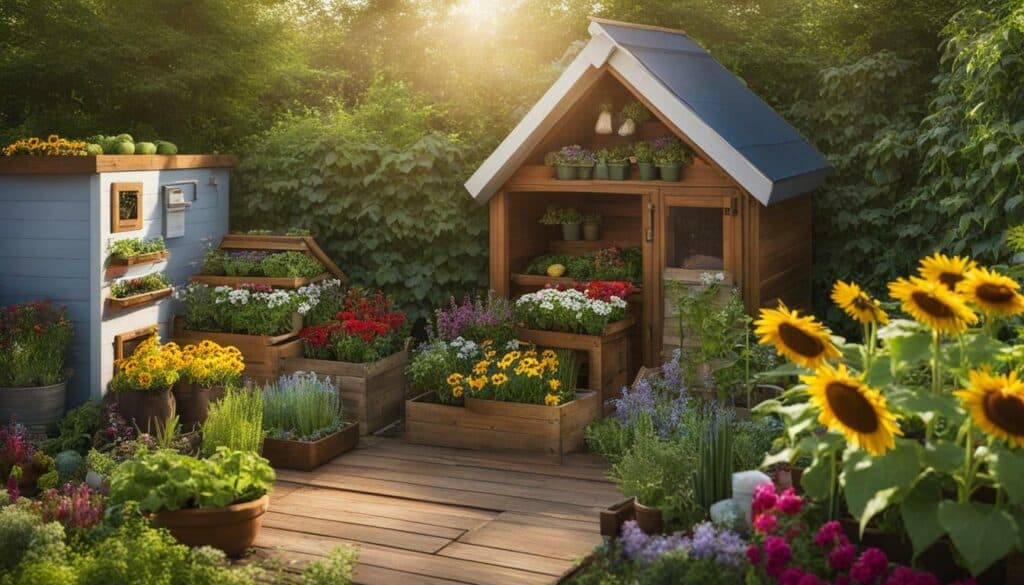
This DIY option is perfect for those who prioritize sustainability in their gardening practices. Not only does it reduce waste by using items that would otherwise be thrown away, but it also removes the need for harmful chemicals typically found in traditional fertilizers.
In addition, this natural fertilizer has been proven to provide the necessary nutrients for plants to thrive, resulting in healthy and vibrant growth.
Coffee Filter Trick for Small Pots
If you have limited space and prefer planting in small pots, here’s a clever trick for you – use coffee filters to keep soil from draining out of the holes. This cost-effective and easy solution ensures proper drainage while keeping the soil intact.
The next time you’re prepping your pot, just place a coffee filter in the bottom. It’ll provide a barrier between the soil and the drainage holes. Fill the pot with soil, plant your seed or sprout, and water as needed. The coffee filter will keep the soil in place so that your plant can thrive in its new home without any worry.
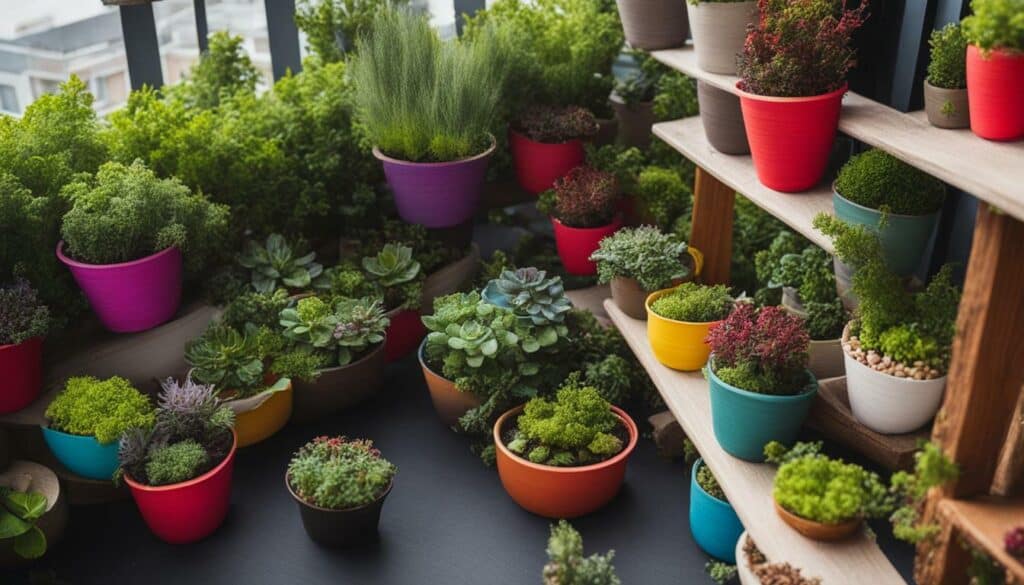
Not only is this a practical solution, but it’s also a creative way to reuse a household item. So next time you brew your coffee, don’t toss those filters away – save them for your next gardening project!
Protecting Tomatoes from Cold Weather
As a beginner gardener, it’s essential to protect your precious tomato plants from the harsh effects of cold weather. Here’s a simple method to help you safeguard their well-being.
One way to protect your tomato plants from cold weather is to wrap their cages with plastic wrap. This provides insulation from cold snaps while still allowing for air circulation. Be sure to remove the plastic wrap once the cold weather has passed to prevent overheating and damage to the plants.
Another technique to protect your tomatoes from the cold is to use mulch. Mulch provides several inches of organic matter around the plants, which helps suppress weeds and retain water. This can be particularly helpful during fluctuating temperatures, as it helps to regulate the soil temperature around the plants.
Collecting rainwater in a water butt is a great way to ensure that your plants have moisture during dry spells, as well as to save on your water bill. Companion planting can also help protect your tomato plants from pests and attract beneficial insects. Planting lavender bushes and Allium plants near your tomatoes can repel pests, while also attracting pollinators to your garden.
By implementing these strategies, you can protect your tomatoes and ensure a successful growing season even in cold weather. Remember to keep an eye on the weather forecast and be prepared to take action to protect your plants as needed.

Using Shipping Tape to Remove Aphids
Dealing with aphids can be frustrating, especially for beginner gardeners. Luckily, there’s a simple and effective method involving shipping tape to remove these pests from your tender plant leaves.
This natural and chemical-free technique is as simple as it sounds. Take a wad of shipping tape and press it onto the affected leaves, gently lift it off, and discard the tape with the captured aphids. This can be done as a spot treatment for existing infestations or as a proactive measure to prevent aphids from settling on your plants.
Regularly inspecting your plants and using shipping tape can help you effectively remove aphids and prevent further damage to your plants. So next time you’re faced with an aphid infestation, don’t panic! Reach for the shipping tape and take control of the situation.
Remember, when it comes to pest control in your garden, natural and chemical-free methods are always the best options.
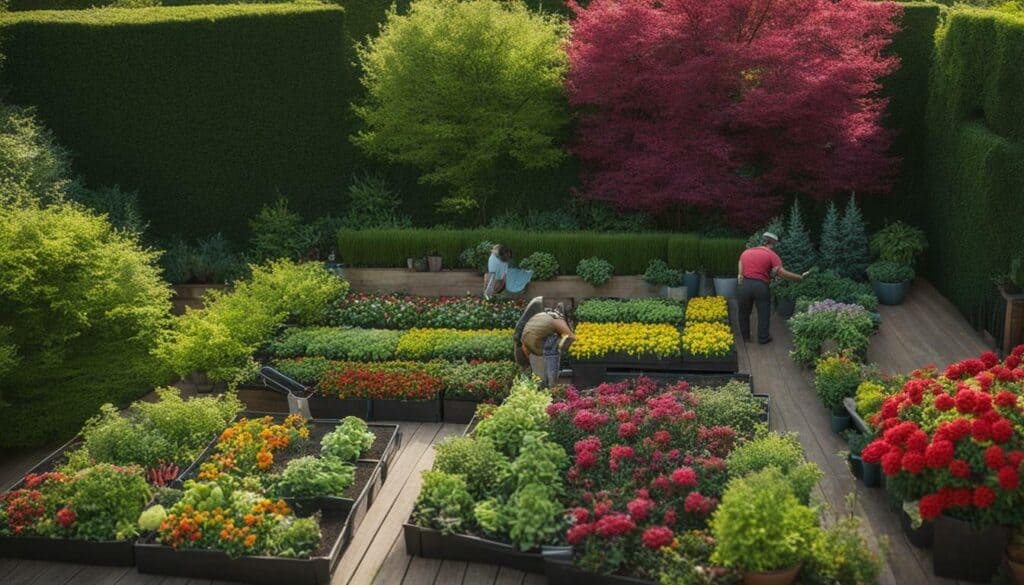
Mulching for Weed Suppression and Water Retention
If you’re aiming for a sustainable garden that minimizes weed growth and conserves water, mulching with organic matter is a tried-and-true technique you shouldn’t overlook. Adding a layer of mulch or chip bark between plants helps to retain moisture in the soil and reduces weed growth. By preserving moisture in the soil, you’ll be able to cut down on water usage, saving money in the long run. Mulching also acts as a natural weed barrier, preventing the growth of unwanted plants. This, in turn, reduces the amount of time and labor required for weeding.
Mulching provides additional benefits beyond weed suppression and water retention. Mulch helps to insulate soil and regulate its temperature. This is particularly helpful during extreme weather conditions to keep the soil from getting too cold or too hot. Mulching prevents water evaporation, keeping the soil and plant roots hydrated for longer periods of time.
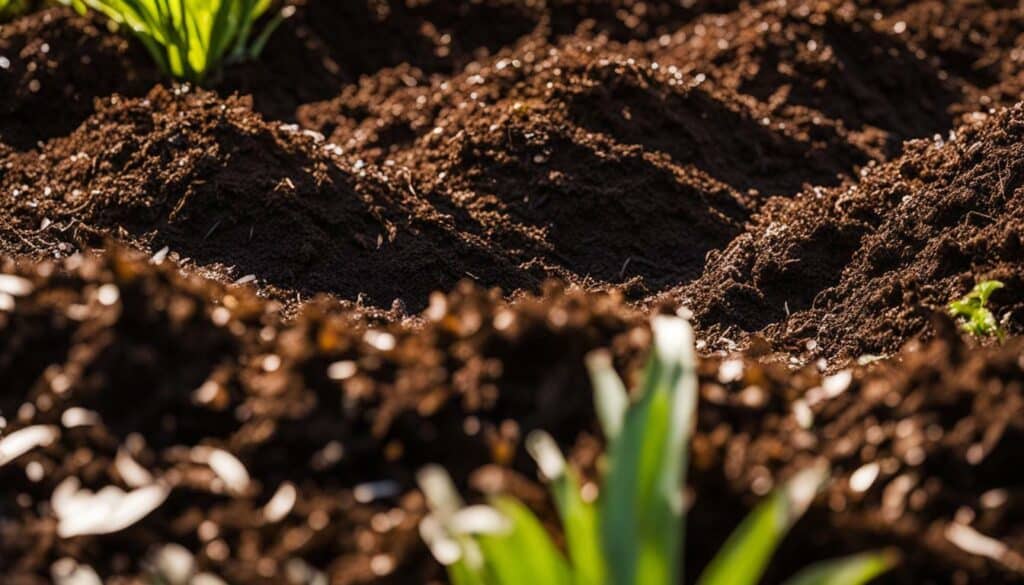
There are several other sustainable gardening practices that can help you maintain a healthy garden ecosystem. Companion planting, for example, involves planting specific combinations of plants that can deter pests and attract beneficial insects. For instance, planting lavender or alliums around your vegetable garden can help keep pests at bay and attract pollinators like bees and butterflies.
Building raised beds is another cost-effective and sustainable gardening practice that can provide numerous benefits. Raised beds allow you to control soil quality, make it easier to harvest crops, and can help reduce soil erosion. They also provide better drainage and aeration for plant roots.
Making your own compost is yet another sustainable gardening practice that can help keep your garden healthy and thriving. By composting food scraps, yard waste, and other organic matter, you can create nutrient-rich soil for your plants. Additionally, collecting rainwater with a water butt can contribute to water conservation in the garden.
Creative Watering Solution for Container Plants
Looking for a sustainable way to keep your container plants hydrated, even when you’re away? A simple kiddie pool filled with water is the perfect solution that can even involve your little ones in the gardening process.
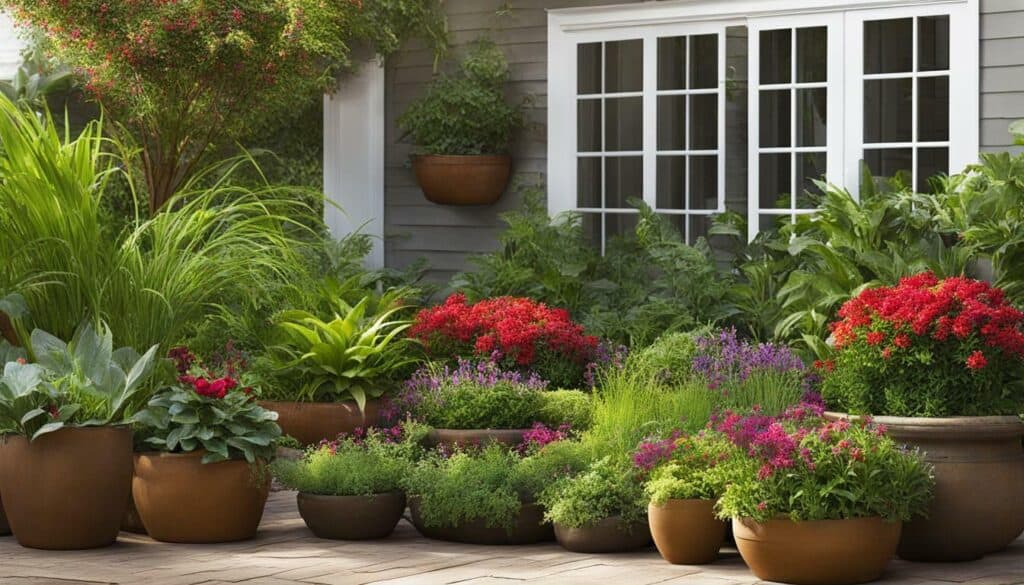
Instead of watering each pot individually or investing in expensive irrigation systems, try this DIY solution. Fill a kiddie pool with water and place your pots inside. The plants will absorb the water through the drainage holes in the bottom of the pots.
This solution not only saves money, but it also saves water by providing a larger reservoir for your plants to draw from. Plus, it’s a fun activity for kids to take part in, helping them learn about sustainability and the importance of taking care of plants.
Remember to choose a spot that receives adequate sunlight for your plants, and make sure to position the pool where it won’t tip over or spill. If you’re worried about mosquitoes breeding in the water, you can add a few mosquito dunks, which are small rings that dissolve to release a larvicide.
With this creative solution, you can enjoy a lush and healthy container garden without the hassle of constant watering. Give it a try and see the difference it can make for your plants.
Final Thoughts on Creating Your Dream Garden for Every Season
Gardening is not only about creating a visually appealing space but also a therapeutic journey that nurtures the soul. Hopefully, these tips and tricks have inspired you to create your dream garden for every season, tailored to your needs and preferences.
One of the most important aspects of gardening is understanding the sunlight exposure and planning accordingly. By choosing the right plants for the right spot, you can save money and effort while achieving optimal results. Don’t forget to give vining plants enough space to grow and avoid overshadowing other plants.
Natural remedies can do wonders for your garden. Epsom salt can improve blooming and growth, while a garlic-hot chili foliage spray can repel insects. Creating your own Miracle Grow with kitchen waste reduces waste and provides natural fertilizer. Also, investing in perennial plants and growing your own fruits and vegetables are cost-effective options.
Participating in plant and seed swaps in your community and regularly removing weeds can help your plants thrive. Mulching and collecting rainwater not only reduce the need for frequent watering but also promote sustainability. Companion planting and DIY methods can save money and labor costs.
Remember, creating your dream garden for every season doesn’t have to be expensive. By implementing these final thoughts and tips, you can transform your garden into a beautiful and therapeutic space without breaking the bank.
FAQ
Q: How important is understanding sunlight exposure for planning a garden?
A: Understanding sunlight exposure is crucial for maximizing the potential of your garden, especially for beginners and those with limited space.
Q: What can Epsom salt do to enhance flower blooming and plant growth?
A: Epsom salt can improve the health and growth of plants, making it beneficial for beginners and those seeking a healthier garden.
Q: How can I repel insects from my plants naturally?
A: You can make a garlic-hot chili foliage spray, which acts as an effective natural insect repellent, catering to those who want to create a garden that attracts wildlife while keeping pests at bay.
Q: Can I make my own version of Miracle Grow?
A: Yes, you can create a DIY Miracle Grow using eggshells, coffee grounds, and banana peels, promoting sustainability in gardening practices.
Q: How can I prevent soil from draining out of small pots?
A: Use a coffee filter in small pots to prevent soil from draining out of the holes, specifically benefiting those working with limited gardening space.
Q: How can I protect tomato plants from cold weather?
A: You can protect tomato plants from cold weather by wrapping plastic wrap around tomato cages, providing essential advice for beginners.
Q: How can I remove aphids from tender leaves?
A: You can effectively remove aphids from tender leaves using shipping tape, making it a valuable technique for beginners.
Q: What are the benefits of mulching?
A: Mulching with organic matter suppresses weeds and retains water, supporting sustainable gardening practices.
Q: How can I keep container plants watered when I’m away?
A: Use a kiddie pool filled with water to ensure container plants stay hydrated, appealing to the sustainability aspect and involving kids in the process.
Q: How can I reduce powdery mildew on plants?
A: Watering with a mixture of baking soda and water can reduce powdery mildew on plants.
Q: What are the benefits of investing in perennial plants?
A: Investing in perennial plants saves money in the long run, making it a cost-effective choice for gardeners.
Q: How can I save money on plant food?
A: Regularly removing weeds reduces the need for plant food, emphasizing the importance of maintaining a weed-free garden.
Q: How can I collect rainwater for my garden?
A: Fit a water butt to your gutter to collect rainwater, promoting sustainability in watering practices.
Q: How can companion planting benefit my garden?
A: Companion planting naturally controls pests and attracts beneficial insects, creating a balanced and healthy garden ecosystem.
Q: Should I consider doing my own gardening instead of hiring a gardener?
A: Doing your own gardening can save money and provide a rewarding and therapeutic experience.
Q: How can I build a raised bed without spending money?
A: You can build a raised bed using free materials like wooden pallets, making it a cost-effective option for creating a garden.
Q: Can I save money on gardening tools?
A: Share or borrow tools with friends, family, or neighbors to save money on purchasing them, promoting a sense of community and resourcefulness.
What are Some Tips for Growing Thai Basil in Different Seasons?
Growing Thai basil in different seasons can be a rewarding experience for those who want to add exotic flavors to their dishes. To grow Thai basil in your garden, ensure it receives at least six hours of sunlight and proper watering. Remember to provide it with well-draining soil and maintain a consistent temperature around 80°F. With these tips, your grow thai basil garden can flourish in any season.
Source Links
- https://www.readygardens.com/10-expert-tips-to-help-you-create-your-dream-garden/
- https://thethriftyislandgirl.com/28-tips-create-your-dream-garden-on-a-budget/
- https://www.gardendesign.com/pdf/how-to-design-your-dream-garden.pdf
- https://getbusygardening.com/how-to-determine-sun-exposure/
- https://www.gardenfundamentals.com/sun-mapping-garden/
- https://youshouldgrow.com/sun-exposure/
- https://www.bobvila.com/articles/epsom-salts-in-the-garden/
- https://www.gardeningknowhow.com/garden-how-to/soil-fertilizers/epsom-salt-gardening.htm
- https://www.hgtv.com/outdoors/flowers-and-plants/epsom-salts-for-plants
- https://oldworldgardenfarms.com/2022/06/09/make-hot-pepper-garlic-spray/
- https://thisismygarden.com/2021/06/use-hot-pepper-spray/
- https://greengoscantina.com/how-to-make-your-own-chili-spray-to-keep-pests-out-of-your-garden/
- https://www.almanac.com/video/are-eggshells-coffee-grinds-and-bananas-good-garden
- https://pakovska.com/garden-diy-fertilizer-from-kitchen-leftovers/
- https://extension.umn.edu/manage-soil-nutrients/coffee-grounds-eggshells-epsom-salts
- https://www.express.co.uk/life-style/garden/1577314/gardening-tips-hacks-coffee-filter-hack-potting-plants-guide
- https://balconygardenweb.com/awesome-coffee-filter-uses-in-the-garden/
- https://www.backyardboss.net/put-coffee-filters-in-your-flowerpots/
- https://www.ruralsprout.com/protect-tomato-plants-from-frost/
- https://ourstoneyacres.com/protecting-your-tomatoes-from-early-frost
- https://www.tomatodirt.com/protect-tomatoes.html
- https://www.housedigest.com/1321231/easily-remove-larvae-eggs-from-plants-tape-hack-leaves/
- http://tcpermaculture.blogspot.com/2011/10/permaculture-tips-duct-tape-cure-for.html?m=1
- https://opticfoliar.ca/top-aphids-facts-and-pest-control-tips-for-your-home-garden/
- https://extension.sdstate.edu/organic-garden-mulches-conserve-moisture-and-prevent-weeds
- https://www.growingreenhouse.com/the-best-mulch-for-water-retention/
- https://www.thespruce.com/mulch-for-weed-control-soil-health-2539779
- https://www.thegardenglove.com/going-on-vacation-3-diy-self-watering-ideas-for-the-garden/
- https://lovelygreens.com/how-to-make-diy-ollas-low-tech-self-watering-systems-for-plants/
- https://empressofdirt.net/self-watering-garden-options/
- https://www.thegardencontinuum.com/blog/first-6-steps-to-create-the-garden-of-your-dreams
- https://www.democratandchronicle.com/story/rochester-magazine/life-style/2016/03/22/dream-garden-key-elements/81926526/
- https://www.floralandhardy.co.uk/the-ultimate-guide-to-designing-and-building-a-dream-garden/





Leave a Reply